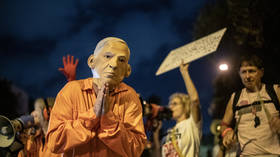
Largest Group Of Lawbreaking Gang Members Is Aged 13 To 16, FBI Report Reveals
Authored by Naveen Athrappully via The Epoch Times (emphasis ours),
The biggest cohort involved in gang activity in the United States is youths 13 to 16 years old, the FBI revealed as part of the agency’s Gang Activity, 2021–2024 special report published on Sept. 8.
 The Federal Bureau of Investigation building in Washington on Aug. 7, 2025. Madalina Kilroy/The Epoch Times
The Federal Bureau of Investigation building in Washington on Aug. 7, 2025. Madalina Kilroy/The Epoch TimesThere were 79,507 offenders engaged in gang activities during the four years, and of these, 19,163 were aged 13 to 16—the highest among all age groups.
This was followed by 17- to 19-year-olds with 13,563 offenders, and those 20 to 24 with 11,452 offenders.
“Over one-third (33.8 percent) of offenders were juveniles under the age of 18, and more than half (58.2 percent) were under the age of 25,” the report said.
Besides being top offenders, the 13- to 16-year age group also accounted for the largest number of victims of gang activity. More than half of the victims were under the age of 30.
“Of known victim-offender relationships for incidents involving gang activity, 67.1 percent of victims knew the offenders in some manner. Conversely, 30.1 percent of relationships described the offenders as strangers.”
According to the Office of Juvenile Justice and Delinquency Prevention, the juvenile justice system in the United States aims to rehabilitate youth found guilty of crimes rather than punish them.
“In many cases, juveniles face much lower maximum possible sentences compared to adults convicted of the same offense,” the Department of Justice’s (DOJ) justice manual states.
“Juveniles under the age of 18 will not be detained past their 21st birthday, and individuals aged 18 to 21 who are being prosecuted as juveniles will face a maximum of five years.”
Charges against juveniles are not pursued as criminal prosecutions but as delinquency proceedings, it said. Juveniles also have robust privacy protections, including sealed records, non-jury trials, and closed rooms.
When a legal system implements softer punishments for children, it’s an incentive for gangs to recruit kids, Daniel Brunner, a retired FBI special agent, said in a post on LinkedIn.

“Gangs seek petty criminals, and they promote teenage recruits to commit petty crimes—presumably because these young recruits are not only undisciplined and easily influenced but also largely immune to serious legal consequences,” he wrote.
“On some occasions, youth which have proven themselves as trust worthy, may be tasked to conduct more serious acts, such as look out for a homicide, sexual assault, and possibly even murder. The legal consequences are typically very weak for younger criminals, especially at the Federal level, allowing these gangs to get away with these crimes.”
‘Not Afraid of Law Enforcement’
Juvenile delinquency was one of the main reasons cited by President Donald Trump for his crackdown on crime in the nation’s capital.
“Crime in Washington, D.C., is totally out of control. Local ‘youths’ and gang members, some only 14, 15, and 16-years-old, are randomly attacking, mugging, maiming, and shooting innocent Citizens, at the same time knowing that they will be almost immediately released,” Trump said in an Aug. 6 post on Truth Social.
He shared a picture of 19-year-old DOGE staff member Edward Coristine, who was attacked last month allegedly by 10 juveniles during an attempted carjacking incident and left bloodied.
“They are not afraid of Law Enforcement because they know nothing ever happens to them, but it’s going to happen now! The Law in D.C. must be changed to prosecute these ‘minors’ as adults, and lock them up for a long time, starting at age 14,” Trump wrote.
Trump federalized the D.C. Metropolitan Police Department on Aug. 11, ordering 800 troops from the National Guard to assist with law enforcement. This past week, the District of Columbia sued the Trump administration, arguing that “the military should not be involved in domestic law enforcement.”
Meanwhile, crime committed by youngsters in school locations has risen over the past several years, according to the FBI’s Crime in Schools, 2020–2024 report.
In 2024, there were 329,424 criminal incidents, more than triple the 100,810 reported in 2020. The age group most frequently reported as offenders was 13 to 15, the FBI said.
Out of the 1.25 million known offenders over the five years, 478,279 were in this age group, followed by 297,873 who were 16 to 18, according to the report.
“Many of the victims were not hurt or suffered only a minor injury and were acquainted with the offender,” it said.
According to a 2017 post by the American Academy of Child and Adolescent Psychiatry (AACAP), some children and adolescents are motivated to join gangs to have a sense of connection in formative years.
Risks of children joining gangs increase when they grow up in areas with high gang activity, lower adult supervision, a lack of hope about the future due to limited education or finances, a lack of positive role models, and unstructured free time.
Parents may face gang retaliation when confronting a child suspected of being a gang member.
Moreover, parents may be held liable for their children’s past behavior, the AACAP said.
Tyler Durden
Fri, 09/12/2025 – 20:55


















